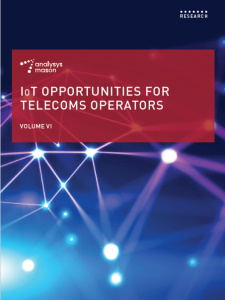IoT opportunities for telecoms operators (volume VI)
We are seeing a split in the IoT market between wide-area and private networks, and this split is reflected in the articles included in our latest collection.
The focus for wide-area networks is on low-power networks that generate little revenue per connection. Operators need to strip out costs and gain scale if they are to succeed. The development of iSIMs, by Arm and others, and the formation of technology partnerships with MVNOs should help the supply side by reducing costs. Government support, as seen in China, helps on the demand side.
Operators are optimistic about gaining more than connectivity revenue in the cases where they provide private networks for industrial customers. These private networks need new operating models and partnerships, and the level of demand is uncertain, as discussed in the first two pieces in this collection.
The articles included here cover the following topics.
- The themes for IoT in 2020 are clear, even without MWC. Competition in cellular connectivity is already intense, and developments such as eUICC and iSIM will increase this further. Operators are looking to private networks to balance the pressures on their public network businesses.
- Industrial IoT: operators must build a strong network of relevant partnerships. Cellular networks have largely failed to meet the needs of the industrial sector. 5G and private networks present a new opportunity for operators to address this sector, but the challenges should not be underestimated.
- Growth in the IoT market will be sizeable, but challenges remain for operators. The number of IoT connections will continue to grow strongly, aided by LPWA networks and rapidly maturing technology. Connectivity revenue and margins will continue to be under pressure due to strong competition and a lack of meaningful differentiation.
- Arm is investing heavily now to achieve long-term IoT revenue growth. Arm has increased R&D spend from 22% of the total revenue in 2015 to 42% in 2018 following its acquisition by SoftBank in 2016. Arm is planning for an IPO in the future, but it may struggle to demonstrate that it has made sufficient progress to attract new investors.
- Chinese operators are dominating the worldwide IoT market, benefiting from a supportive government. The Chinese government has played an instrumental role in supporting the development of technology and new markets for IoT. Governments in the rest of the world have lessons to learn.
- MNOs and MVNOs: from competition to collaboration to expand the IoT connectivity opportunity. The role of MVNOs in IoT is shifting from being a channel to market for operator connectivity to a supplier of advanced technology.
As well as our research, Analysys Mason's consulting division helps clients in all geographies and parts of the value chain to develop their approaches to IoT. Our assignments range from rapid reviews of existing plans to full strategy development. Please contact us for more details about our research programmes or consulting capabilities.
Finally, we send a monthly newsletter highlighting our latest business services research to around 6000 people. Please contact us if you would like to be included in the mailing list.

This white paper is our sixth collection of articles based on the IoT market and assesses the impact of IoT developments on telecoms operators.
Author

